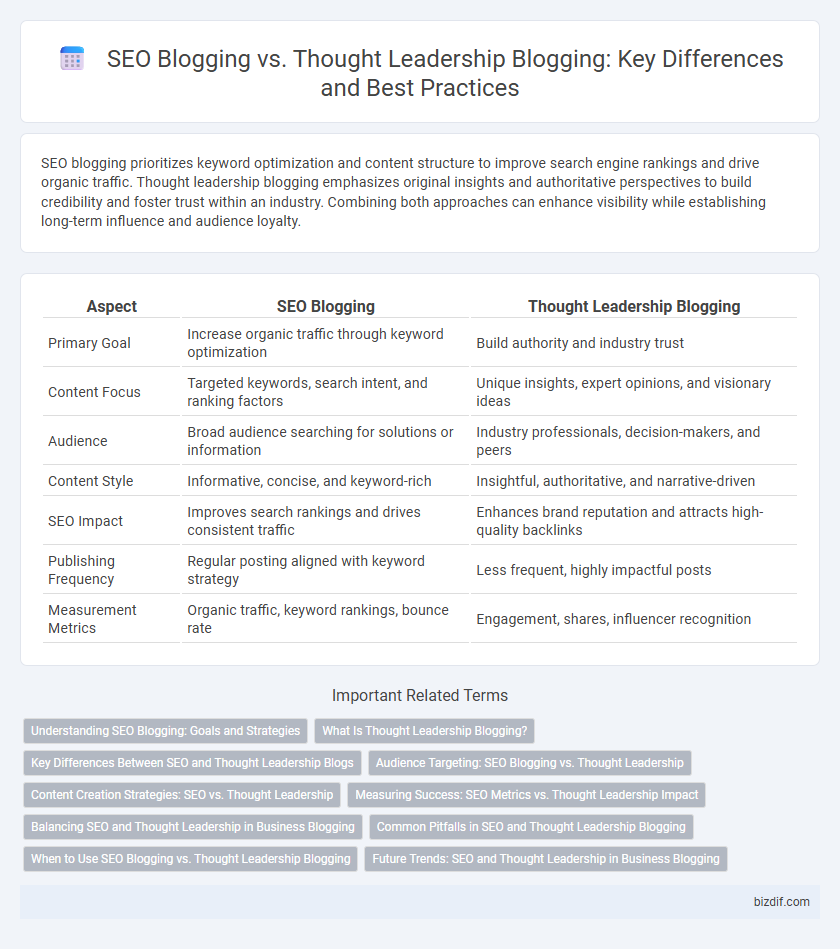SEO blogging prioritizes keyword optimization and content structure to improve search engine rankings and drive organic traffic. Thought leadership blogging emphasizes original insights and authoritative perspectives to build credibility and foster trust within an industry. Combining both approaches can enhance visibility while establishing long-term influence and audience loyalty.
Table of Comparison
| Aspect | SEO Blogging | Thought Leadership Blogging |
|---|---|---|
| Primary Goal | Increase organic traffic through keyword optimization | Build authority and industry trust |
| Content Focus | Targeted keywords, search intent, and ranking factors | Unique insights, expert opinions, and visionary ideas |
| Audience | Broad audience searching for solutions or information | Industry professionals, decision-makers, and peers |
| Content Style | Informative, concise, and keyword-rich | Insightful, authoritative, and narrative-driven |
| SEO Impact | Improves search rankings and drives consistent traffic | Enhances brand reputation and attracts high-quality backlinks |
| Publishing Frequency | Regular posting aligned with keyword strategy | Less frequent, highly impactful posts |
| Measurement Metrics | Organic traffic, keyword rankings, bounce rate | Engagement, shares, influencer recognition |
Understanding SEO Blogging: Goals and Strategies
SEO blogging focuses on optimizing content to improve search engine rankings by targeting relevant keywords, enhancing site structure, and increasing organic traffic. Key strategies include keyword research, on-page optimization, link building, and creating high-quality, informative content tailored to user intent. The primary goal is to boost visibility, attract potential customers, and drive conversions through search engine results pages (SERPs).
What Is Thought Leadership Blogging?
Thought leadership blogging positions a brand or individual as an expert by delivering insightful, forward-thinking content that challenges industry norms and offers innovative solutions. Unlike SEO blogging, which prioritizes keyword optimization and search engine rankings, thought leadership centers on building trust, credibility, and long-term relationships with an engaged audience. It leverages deep industry knowledge and unique perspectives to influence opinions and drive meaningful conversations within a niche.
Key Differences Between SEO and Thought Leadership Blogs
SEO blogging centers on keyword optimization, targeting search engine rankings to drive organic traffic through strategically placed terms and meta descriptions. Thought leadership blogging emphasizes originality and expertise, establishing the author's authority and fostering trust by providing in-depth insights and visionary perspectives. While SEO blogs often prioritize volume and technical structure, thought leadership blogs focus on quality content that influences industry trends and shapes opinions.
Audience Targeting: SEO Blogging vs. Thought Leadership
SEO blogging targets broad audiences by optimizing content for specific keywords to improve search engine rankings, driving high volumes of organic traffic. Thought leadership blogging focuses on niche, influential audiences by delivering insightful, authoritative perspectives that establish credibility and foster deeper engagement. Effective audience targeting balances keyword research with understanding the interests and pain points of a specialized community to maximize reach and impact.
Content Creation Strategies: SEO vs. Thought Leadership
SEO blogging prioritizes keyword research, targeted content, and on-page optimization to drive organic traffic and improve search engine rankings. Thought leadership blogging emphasizes original insights, industry expertise, and engaging storytelling to build authority and foster trust with a specific audience. Content creation strategies for SEO focus on scalability and measurable metrics, while thought leadership relies on depth, authenticity, and long-term relationship building.
Measuring Success: SEO Metrics vs. Thought Leadership Impact
Measuring success in SEO blogging revolves around metrics like organic traffic, keyword rankings, bounce rates, and conversion rates, which quantify visibility and user engagement. Thought leadership blogging success is evaluated through brand authority, audience trust, social shares, and influence on industry conversations, reflecting the depth of impact beyond immediate traffic. Combining data-driven SEO analytics with qualitative indicators of thought leadership ensures a comprehensive assessment of blog performance.
Balancing SEO and Thought Leadership in Business Blogging
Balancing SEO and thought leadership in business blogging ensures content ranks well on search engines while establishing industry authority and trust. Integrating targeted keywords with insightful, original perspectives drives organic traffic and fosters meaningful audience engagement. Combining data-driven SEO strategies and authentic thought leadership cultivates a loyal readership and enhances brand credibility.
Common Pitfalls in SEO and Thought Leadership Blogging
SEO blogging often falls into the trap of keyword stuffing and low-quality backlinks, which can harm search engine rankings and reader trust, while thought leadership blogging struggles with vague messaging and lack of unique insights that fail to engage or differentiate the brand. Both approaches risk inconsistency in publishing frequency, reducing audience retention and diminishing the blog's authority over time. Effective blogging requires balancing SEO tactics with authentic, high-value content to avoid these common pitfalls and drive meaningful engagement.
When to Use SEO Blogging vs. Thought Leadership Blogging
SEO blogging is ideal for driving targeted traffic through keyword-rich content optimized for search engines, especially when aiming to increase visibility and attract new visitors quickly. Thought leadership blogging suits brands seeking to establish authority and build trust by sharing expert insights and original perspectives on industry trends. Use SEO blogging for product launches or promotional campaigns, while thought leadership blogging excels in nurturing long-term relationships and differentiated brand identity.
Future Trends: SEO and Thought Leadership in Business Blogging
SEO blogging will increasingly integrate AI-driven keyword analysis and voice search optimization to enhance content discoverability and user engagement. Thought leadership blogging will prioritize authenticity, storytelling, and data-driven insights to build trust and foster long-term audience relationships. Businesses combining advanced SEO techniques with a strong thought leadership presence will dominate future digital marketing landscapes, driving both traffic and brand authority.
SEO Blogging vs Thought Leadership Blogging Infographic

 bizdif.com
bizdif.com